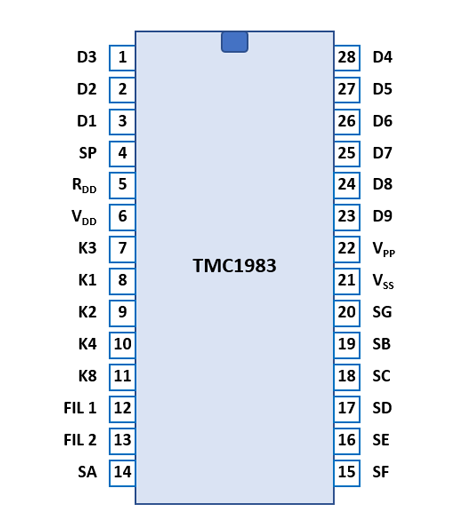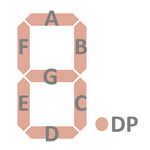
DATAMATH CALCULATOR MUSEUM
 |
DATAMATH CALCULATOR MUSEUM |
The TMC0980 family of single-chip calculator circuits was introduced in June 1976 with the two scientific calculators SR-40/TI-30 and the financial calculator Business Analyst of the Majestic product line. The TMC0980 is an extension of the TMS1000 Microcomputer Product Family and allows for highly cost optimized calculators with up to 40 keys and a 9-digit LED Display powered by a 9V battery. Additional cost savings could be achieved by replacing a conventional [ON-OFF] switch with a simple push-button [ON] key. The TMC0980 chip includes 18,432 Bits Read-Only Memory (ROM, 2k*9 Bits) and 576 Bits Random-Access Memory (RAM, 9 Registers * 16 Digits), a 4-bit Arithmetic unit, a programmable PLA for segment decoding and both segment and digit drivers for a 9-digit LED Display.
Due to a flexible design concept with both programmable ROM and segment decoder some design variations of the TMC0980 were introduced and Texas Instruments expanded the product family before finally converting the design with the TP0320 from a 9V metal gate PMOS process to a 3V metal gate CMOS process:
|
• TMC1980: 9-digit, 7-segment VF-Display, 28-pin Package (Dataman) • TMC0260: 11-digit, 7-segment VF-Display, Thermal Printer Interface, 40-pin Package (TI-5040) • TMC0270: 9-digit, 14-segment VF-Display, 40-pin Package (Speak & Spell) |
The TMC1980 was introduced in June 1977 with the TI-1680 Replay Calculator but made a much more lasting appearance with the Dataman Educational Toy. The TMC1980 replaced the segment and digit drivers for a 9-digit LED Display with high-voltage drivers for a VF-Display and includes both an integrated charge pump driver to generate the high voltage (around -22V) for the Anodes and Grids of the VF-Display and integrated drivers for the Filament (heater) of it.
| Type | Calculator/Product | Application | Comments |
| TMC1981 | TI-1680, TI-2550 IV | Replay Calculator | Uses TMC0999 memory |
| TMC1982 | TI Dataman | Educational | Single-chip application |
| TMC1983 | TI-45 | Scientific | Like SR-40 w/ VF-Display |
| TMC1984 | Spelling B | Educational | TMC0272 Master |
| TMC1986 | Math Marvel | Educational | Single-chip application |
| Description | Comments | |
| Architecture | Single-chip Calculator | Scientific, Financial |
| Category | Digit Processor | 4-bit Digits |
| Related |
TMC0980 TMC0260 TMC0270 |
7-segment LED-Display 7-segment VF-Display, Printer 14-segment VF-Display |
| ROM Size | 18,432 Bits | 2048 Words * 9 Bits |
| RAM Size | 576 Bits | 9 Registers * 16 Digits |
| Outputs | 9 Digits, 8 Segments | Internal VFD Digit and Segment Drivers, Filament and Charge pump Drivers |
| Inputs | 5 Keyboard 1 Oscillator Mode |
Digit to Keyboard Scan-Matrix |
| Item | Min | Typ | Max | Unit | Comments |
| VSS | 0 | V | |||
| VDD | -9.0 | V | |||
| VPP | -22.0 | V | |||
| CK | 250 | 350 | 450 | kHz | Internal oscillator |
The TMC1980 was manufactured in a 6 um metal gate PMOS process (metal width = 0.25 mil / 6.0 um, metal spacing = 0.25 mil / 6.0 um, diffusion width = 0.15 mil / 4.0 um, diffusion spacing = 0.30 mil / 8.0 um).
The die size of the TMC1980 is approximately 195 mils * 190 mils / 4.9 mm * 4.8 mm.
The TMC1980 uses a 0.4” wide 28-pin SPDIP (Shrink Plastic Dual In-line Package with a 0.07” / 1.778 mm lead pitch).
TMC1982 (Dataman)
| Pin | IO | Function | Pin | IO | Function |
| 1 | O | Digit driver 3 | 28 | O | Digit driver 4 |
| 2 | O | Digit driver 2 | 27 | O | Digit driver 5 |
| 3 | O | Digit driver 1 (LSD) | 26 | O | Digit driver 6 |
| 4 | O | Segment driver DP | 25 | O | Digit driver 7 |
| 5 | O | Voltage Tripler Output | 24 | O | Digit driver 8 (MSD) |
| 6 | V | Negative Voltage VDD | 23 | O | Digit driver 9 (sign) |
| 7 | I | Keymatrix input 1 | 22 | V | Display Voltage VPP |
| 8 | I | Keymatrix input 2 | 21 | I | Oscillator Mode |
| 9 | I | Keymatrix input 4 | 20 | V | Positive Voltage VSS |
| 10 | I | Keymatrix input 8 | 19 | O | Segment driver G |
| 11 | O | Filament driver 1 | 18 | O | Segment driver B |
| 12 | O | Filament driver 2 | 17 | O | Segment driver C |
| 13 | O | Segment driver A | 16 | O | Segment driver D |
| 14 | O | Segment driver F | 15 | O | Segment driver E |
 TMC1983 (TI-45)
TMC1983 (TI-45)| Pin | IO | Function | Pin | IO | Function |
| 1 | O | Digit driver 3 | 28 | O | Digit driver 4 |
| 2 | O | Digit driver 2 | 27 | O | Digit driver 5 |
| 3 | O | Digit driver 1 (LSD) | 26 | O | Digit driver 6 |
| 4 | O | Segment driver DP | 25 | O | Digit driver 7 |
| 5 | O | Voltage Tripler Output | 24 | O | Digit driver 8 (MSD) |
| 6 | V | Negative Voltage VDD | 23 | O | Digit driver 9 (sign) |
| 7 | I | Keymatrix input 3 | 22 | V | Display Voltage VPP |
| 8 | I | Keymatrix input 1 | 21 | V | Positive Voltage VSS |
| 9 | I | Keymatrix input 2 | 20 | O | Segment driver G |
| 10 | I | Keymatrix input 4 | 19 | O | Segment driver B |
| 11 | I | Keymatrix input 8 | 18 | O | Segment driver C |
| 12 | O | Filament driver 1 | 17 | O | Segment driver D |
| 13 | O | Filament driver 2 | 16 | O | Segment driver E |
| 14 | O | Segment driver A | 15 | O | Segment driver F |
| The Segment drivers A-G and DP (Decimal Point) are connected to the display in the pictured way. |  |
The keyboards of products based on the TMC1980 Product Family consist of an x/y-matrix connected to up to seven digit outputs with the top row ([ON] key) connected to VSS and the keymatrix inputs K1, K2, K4, K8. The TMC1983 used with the TI-45 has the "virtual" keymatrix input K3 bonded to a Pin 7 but drops the Oscillator Mode input instead. With the "virtual" keymatrix K3 activating both K1 and K2 together, reflects the keyboard of the TI-45 an interesting layout with K1 and K2 positioned in the outmost columns and K3 in the center column to avoid any unexpected behavior of the calculator when pushing neighboring keys together.
Example for the Dataman with TMC1982:
| K4 | K3 | K2 | K1 | |
| VSS | Electro Flash | [?] | OFF | ON |
| D5 | Wipe Out | Number Guesser | Force Out | ÷ |
| D6 | 7 | 8 | 9 | × |
| D7 | 4 | 5 | 6 | − |
| D8 | 1 | 2 | 3 | + |
| D9 | GO | 0 | Memory Bank | = |
Example for the TI-45
with TMC1983:
| K2 | K8 | K3 | K4 | K1 | |
| VSS | 1/x | x2 | √x | OFF | ON |
| D9 | INV | sin | cos | tan | DRG |
| D8 | K | EE | log | lnx | yX |
| D7 | PI | % | ( | ) | ÷ |
| D6 | STO | 7 | 8 | 9 | × |
| D5 | RCL | 4 | 5 | 6 | − |
| D4 | SUM | 1 | 2 | 3 | + |
| D3 | EXC | 0 | . | +/− | = |
Calculators based on the TMC1980 make use of low-voltage 9-digit VFDs (Vacuum Fluorescent Displays).
If you have additions to the above datasheet please email: joerg@datamath.org.
© Sean Riddle and Joerg Woerner, April 6, 2021. No reprints
without written permission.